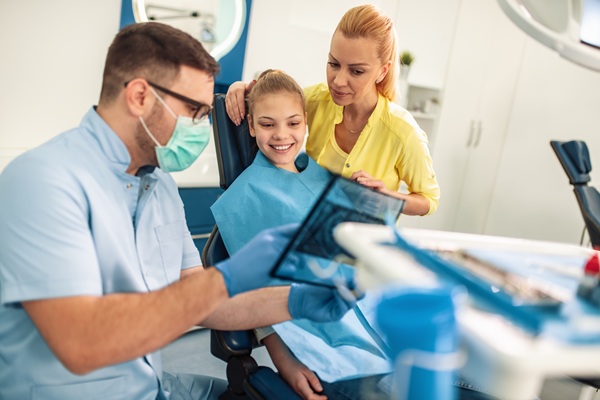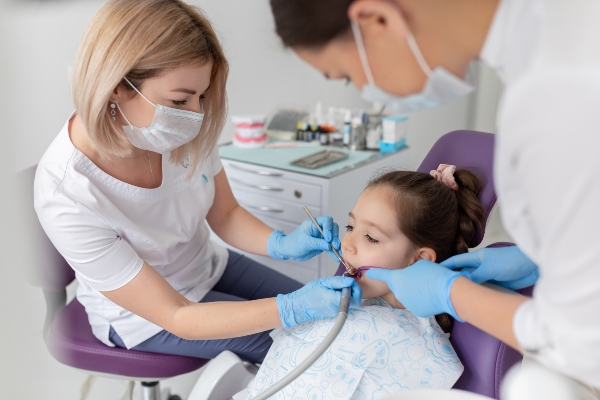Pediatric Dental Checkup: Understanding Dental X-Rays

Lifelong oral health begins with pediatric dental checkups, and routine dental X-rays are an integral part of that care. They show how well teeth are forming, vulnerable areas in the enamel, and whether the jawbone and gums are developing as expected. Reading up on the basics of X-rays can help parents feel more confident and comfortable ahead of a checkup.
Why X-rays matter in pediatric dentistry
Dental X-rays reveal early decay that commonly begins between teeth, beneath chewing surfaces, or around existing restorations. They also show the height and contour of the part of the jawbone supporting the teeth, which helps pediatric dentists track gum health and inflammation risk. In addition, being able to see developing tooth buds and root shapes enables the dentist to make recommendations that match a child’s stage of growth. This precision supports oral development and keeps any dental treatments as minimally invasive as possible.
Types of dental X-rays and what they look at
There are three main types of dental X-rays used during pediatric dental checkups. The first are bitewing images, which capture the contact points where childhood cavities often start. These views help pediatric dentists measure lesion depth and determine whether it is possible to handle enamel-only spots non-invasively. Because the field is small and exposures are brief, most children find bitewing X-rays easy to sit for.
Next are periapical images. These X-rays capture the entire length of a tooth and the surrounding jawbone. They are essential for detecting injuries, abscesses, and unusual root shapes that could affect tooth eruption or future treatment.
Finally, panoramic X-rays provide a comprehensive view of the jaw, sinuses, and developing teeth in a single image. During a pediatric dental checkup, these X-rays are useful for evaluating eruption sequence, extra or missing teeth, and growth patterns that influence orthodontic timing. Many dentists take panoramic X-rays at key milestones to keep checkups efficient.
How often are X-rays needed?
Frequency depends on risk, not a fixed calendar. Children who get pediatric dental checkups every six months, have a low-sugar diet, and good oral hygiene may only need X-rays every year or so. Those with previous cavities, enamel defects, or orthodontic appliances typically benefit from more frequent checks. In cases of tooth pain or dental trauma, X-rays will likely be necessary that day to provide a more detailed look at the teeth.
When X-rays change the plan
In the best-case scenario, X-rays will reveal a hidden problem before it causes pain or visible damage. That is why staying on track with pediatric dental checkups is so important. These appointments are meant to maintain a smile through preventive measures and by detecting oral health problems early. For example, an X-ray can reveal an early-stage cavity that may only require a small dental filling rather than a full dental crown later on. They may also reveal a hidden infection at a tooth root, enabling timely care to protect nearby teeth.
On the other hand, some children naturally have missing, extra, or even joined (fused) teeth, which can change how much space is available and when teeth come in. A simple panoramic X-ray can spot these differences early, so the dentist can map out a smart plan. This usually involves either holding space with a space maintainer or removing a tooth. X-rays also show the path of incoming teeth and how much room they have, making it easier to catch crowding or impaction.
How safe are the X-rays used during pediatric dental checkups?
According to the American Dental Association (ADA), dental X-rays are considered safe for children. For added protection, patients can wear lead aprons and thyroid collars to shield themselves. Digital sensors also bring less radiation than traditional film, while still producing crisp images in seconds.
Preparing your child for dental X-rays
Ahead of a pediatric dental checkup, parents can help prepare their children for dental X-rays. Practicing with a spoon as a makeshift X-ray sensor can make the process feel more familiar once in the office. In addition, schedule the checkup when the child is rested and not overly hungry to improve cooperation. Make sure to also praise small successes, such as following a one-step cue, to set a positive tone for the visit.
Comfort strategies during the pediatric dental checkup
From the moment the child enters the office, the dental team strives to help them feel comfortable and confident. The pediatric dentist explains each step in simple, age-appropriate language and offers small choices, such as which side to start on, to give the child a sense of control. They also use calm, one-step cues and counting to focus attention during the imaging process. Short practice bites and gentle positioning help reduce gag reflex triggers, while brief pauses between exposures prevent fatigue and keep the patient cooperative.
Book a pediatric dental checkup
A pediatric dental checkup that includes X-rays delivers clarity that visual exams alone cannot achieve. Imaging reveals hidden decay, confirms healthy development, and guides referrals or treatment at the right moment. To learn more or to schedule your child’s appointment, contact our Richmond office today.
Request an appointment here: https://www.grandparkwaypediatricdental.com or call Grand Parkway Pediatric Dental at (832) 579-0960 for an appointment in our Richmond office.
Check out what others are saying about our dental services on Yelp: Dental Checkup in Richmond, TX.
Recent Posts
An early dental checkup for kids can help give your child a good start in life. The pediatric dentist will perform a comprehensive dental exam. This can determine if your child needs early corrective dental treatments. Here are the benefits of an early dental checkup for kids.Children always want to feel comfortable. The early dental…
For a dental check-up for kids, as well as cleanings and restorations, parents frequently turn to their dentist. Bringing your child to a regular dentist is not always ideal, though. Every child should get the specialized care provided by a pediatric dentist, as they offer dental treatment for children from infancy through adolescence.Many parents are…
Brushing and flossing at home is a good start toward ensuring excellent oral health for your child, but you must not skip a pediatric dental check-up. Routine appointments are essential for preventing tooth decay and cavities. If you have concerns regarding your child's dental health, you can ask questions during the appointment. The pediatric dentist…
A child's first dental checkupDental anxiety and fear can begin at any age, but it can be a particularly difficult issue among children. The American Academy of Pediatric Dentistry recommends that you take your child to their first dental checkup within six months of the eruption of their first tooth. Starting the dental visits early…


